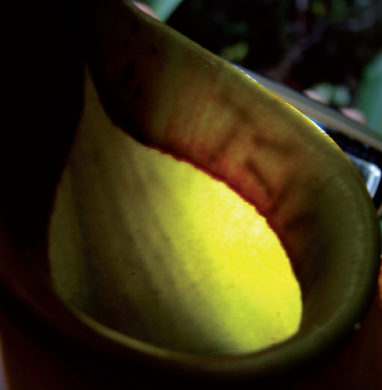Scientists have discovered the first example of an ant-plant tag-team that works together to provide food for  both.
both.
The plant is a member of the Nepenthes family, which characteristically use liquid-filled pitchers to trap and digest insects that tumble in. And as these unfortunates are consumed, the nutrients locked up inside them are absorbed, enabling the plants to thrive in impoverished soils.
But one species found in the rainforest of Borneo, Nepenthes bicalarata, appears to have taken things a step further. It recruits an army of (Camponotus schmitzi) ants that help to defend the plant, ambush prey, clean up the pitcher traps and, we now know, share in the food spoils.
The plant provides barracks for its resident defense force in the form of hollow structures called dormatia that are sited close to the pitchers. The ants are also rewarded with a sugar meal dispensed from "field kitchen" nectaries within the pitchers.
In return, the ants ambush passing insects, including other ant species, clean away fungal deposits from the necks of the pitchers to keep them slippery and fight off herbivores trying to make a meal of the plant itself.
What's really surprising though, is that the C. schmitzi ants, which appear to be uniquely associated with this pitcher species, also eat the nitrogen-rich prey that tumbles into the trap.
This sounds like bad news for the plant, but by doing so, and then contributing their own faeces and carcasses into the pitchers, the ants are effectively substituting their own superior digestive systems for the plant's less-effective one, dramatically improving the efficiency of nutrient release from the prey items.
At the same time, by retrieving bulky prey items from the traps, the ants also help to prevent a build up in the pitcher fluid of ammonia and other putrefaction products that could knock out the bacterial communities that also live there and help in the food-breakdown process.
This discovery, which is the work of University of Montpellier II researcher Vincent Bazile and his colleagues and published this week in the journal PLoS One, is the first description of a carnivorous plant and ant species working together in this way.
The team compared the growth, nitrogen content and trapping success of Nepenthes bicalcarata plants with and without ant colonisers. The results were clear: plants colonised by the ants had signficantly larger leaves and bigger pitchers containing twice as much prey biomass. Nitrogen levels in the plant were also three times greater in ant-colonised specimens, with up to 75% of it coming via the ants.
According to the researchers, "this mixed strategy represents an outstanding adaptation for the exploitation of nutrient-poor soils and is, to our knowledge, unique in the plant kingdom."










Comments
Add a comment